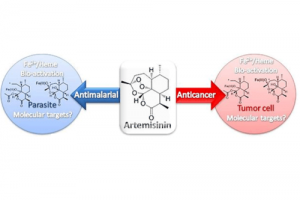Mechanisms of Action: How Artemisinin Targets Parasites
Introduction
Malaria claims hundreds of thousands of lives annually. In the ongoing battle against this disease, artemisinin stands as a beacon of hope. This remarkable compound comes from the sweet wormwood plant (Artemisia annua), and it has dramatically transformed the landscape of antimalarial therapy.

The Action Mechanisms of Artemisinin [1]
This article delves into the sophisticated mechanisms of artemisinin and its derivatives. Hope that you can have a detailed understanding of their features and action mechanisms.
The Nature of Artemisinin
Artemisinin is a naturally occurring compound that has become a cornerstone in the treatment of malaria. It is extracted from the plant Artemisia annua, also known as sweet wormwood or Qinghao in traditional Chinese medicine. Its discovery and development into a potent antimalarial drug is a fascinating story of scientific innovation meeting ancient wisdom.
–Uses and Applications
Artemisinin and its derivatives, such as artesunate, artemether, and dihydroartemisinin, are primarily used in combination with other antimalarial drugs as part of artemisinin-based combination therapies (ACTs).
ACTs are the World Health Organization’s recommended treatment for uncomplicated malaria caused by Plasmodium parasite, particularly in Africa. These combinations are designed to increase the efficacy of treatment, reduce the treatment duration, and diminish the chances of resistance development by the parasites.
The Biochemical Onslaught
Artemisinin’s mechanism of action is a masterclass in biochemical warfare. It operates through a series of complex interactions that disrupt the lifecycle of the Plasmodium parasite within the human host. It particularly targets the erythrocytic (blood) stage of the parasite’s lifecycle.
The primary mode of action can be broken down into several key processes:
1. Activation by Iron
The artemisinin compound contains a unique endoperoxide bridge, which is activated upon exposure to iron.
Inside the infected erythrocytes, the Plasmodium parasite ingests hemoglobin as a nutrient source. It also releases heme, an iron-containing compound. Artemisinin and its derivatives interact with this heme to produce free radicals through the cleavage of its endoperoxide bridge.
2. Generation of Reactive Oxygen Species (ROS)
The interaction with iron unleashes reactive oxygen species (ROS).
These highly reactive molecules attack various parasite structures. These ROS are detrimental to the parasite, so they cause oxidative damage to proteins, lipids, and nucleic acids, which are crucial for the Plasmodium parasite ‘s survival and replication.
3. Disruption of Mitochondrial Function
Artemisinin’s assault does not end with the generation of ROS. It extends to the mitochondria, the energy factories of the cell.
By damaging the mitochondria, artemisinin and its derivatives disrupt the energy supply to the parasite. In this way, it further cripples the parasite’s ability to survive and proliferate within the red blood cells.
4. Inhibition of PfATP6
Research has also pointed towards the inhibition of PfATP6. This is a calcium ATPase enzyme in the parasite’s endoplasmic reticulum, as a mechanism of action.
This inhibition disrupts the calcium ion homeostasis within the parasite. It affects the Plasmodium parasite’s ability to regulate various essential functions and leads to its demise.
5. Interference with Hemoglobin Digestion
The parasite relies on the digestion of hemoglobin for its growth and reproduction. Artemisinin interferes with this process.
This herbal extract obstructs the parasite’s nutrient acquisition pathway. Therefore, it starves the parasite of the essential components needed for its survival.
The Selective Toxicity
A fascinating aspect of artemisinin’s mechanism is its selective toxicity towards infected erythrocytes over non-infected ones. This selectivity is thought to be due to the higher concentrations of free heme available in infected cells, which catalyzes the activation of artemisinin, sparing healthy cells from its oxidative onslaught.
The Implications of Artemisinin Resistance
Despite its efficacy, the emergence of artemisinin resistance in some regions poses a significant challenge since it comes with slower parasite clearance times.
Resistance is believed to result from mutations in the Plasmodium falciparum kelch13 (Pfkelch13) gene. It affects the drug’s ability to target the parasite effectively. This development underscores the need for continued vigilance and innovation in antimalarial drug research.
Advancements and Future Directions
The fight against malaria is far from over, and artemisinin’s role in this battle is evolving.
- Researchers are exploring new derivatives and combination therapies to overcome resistance and enhance the drug’s efficacy.
- The development of synthetic biology approaches to produce artemisinin more efficiently and sustainably is also a promising avenue, ensuring its availability to those in need.
Conclusion
In summary, artemisinin‘s multifaceted attack against the Plasmodium parasites showcases the compound’s critical role in the global fight against malaria. From the activation by iron and the generation of reactive oxygen species to the disruption of mitochondrial function, inhibition of PfATP6, and interference with hemoglobin digestion, each mechanism contributes to the compound’s potent antimalarial effects. This comprehensive approach makes artemisinin and its derivatives invaluable assets in the ongoing battle against malaria.
As the fight against malaria continues, with challenges such as drug resistance and the need for new treatment strategies, artemisinin remains a beacon of hope. The story of Artemisinin is not just a testament to scientific ingenuity but also a call to action for the global health community to sustain and expand efforts to combat malaria and save lives around the world. For more information, please check our homepage at https://www.stanfordchem.com/.
Reference:
[1] O’Neill, P.M.; Barton, V.E.; Ward, S.A. The Molecular Mechanism of Action of Artemisinin—The Debate Continues. Molecules 2010, 15, 1705-1721. https://doi.org/10.3390/molecules15031705
